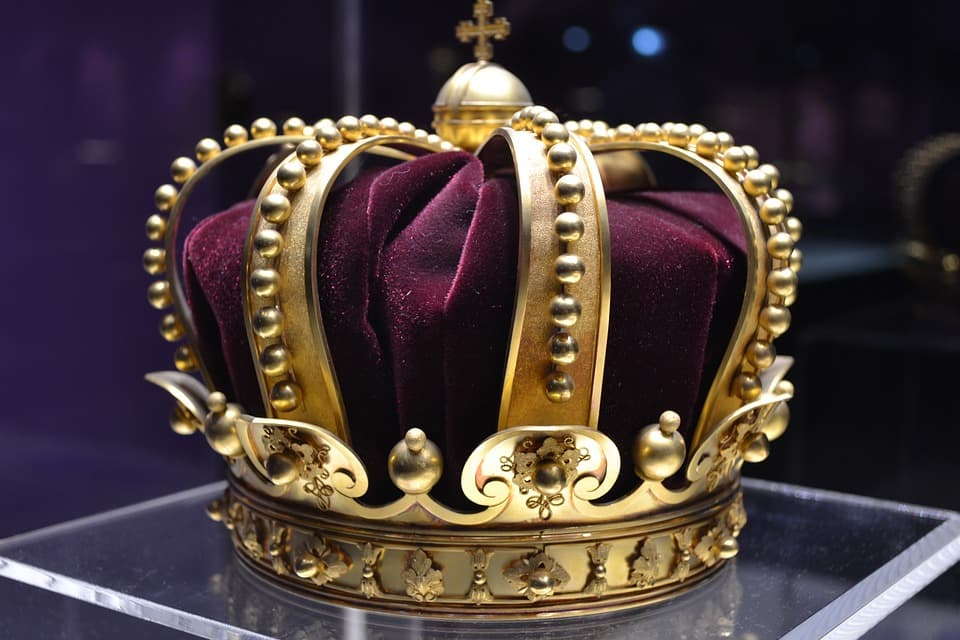
The coronation regalia, currently housed in the Tower of London, is a sacred collection which will play an incredibly significant role in the King’s crowning ceremony. Amongst the coronation regalia are three impressive crowns which you can expect to see during the King and Queen’s coronation on the 6th May 2023…
St Edward’s Crown
Traditionally, the only time the St Edward’s Crown is worn is during the moment of crowning. Made for King Charles II in 1661, this crown was a replacement for the original crown which had been melted down in 1649. It is believed that the original crown dated back to the eleventh-century for King Edward the Confessor. Conventionally, the crown was not allowed to leave Westminster Abbey, therefore, a second crown was created for the procession out of the coronation ceremony.
Although it is not an exact replica, the St Edward’s Crown was commissioned by the Crown Jeweller at the time, Robert Vyner, and features four crosses-pattée and four fleurs-de-lis, and two arches. Weighing almost five pounds, the St Edward’s Crown is one of the heaviest royal crowns, and is topped with an orb and a cross to symbolise the Christian faith. The solid gold frame also features precious stones such as rubies, sapphires, topazes, amethysts, garnet and tourmalines. It is reported that Queen Elizabeth II practised walking with bags of flour on her head to get used to the weight ahead of her coronation in 1953.
Imperial State Crown
The Imperial State Crown, or Crown of State, is typically worn by the monarch to process out of the Abbey, after the coronation ceremony. It is also used for other ceremonial occasions, like the annual State Opening of Parliament. This crown is relatively new in comparison to other crowns in the royal collection, having been made in 1937 for King George VI’s coronation, and was designed based on an earlier crown for Queen Victoria in 1838, with the orb and cross on the top being directly transferred from the original.
The term ‘imperial state crown’ dates back to the fifteenth century, and refers to English monarchs who chose a crown design which is closed by arches and demonstrates that England was not subject to any other earthly power. Also made with a solid gold frame, the crown features 2,868 diamonds, as well as sapphires, emeralds and pearls. It features legendary jewels such as the Black Prince Ruby, which is said to have been worn in Henry V’s helmet at the Battle of Agincourt. It is also believed that the four large pearls which hang from the arch were once worn by Elizabeth I, and the Stuart Sapphire on the back of the crown is thought to be associated with the Stuart Kings.
Queen Mary’s Crown
The crown of Queen Mary is a consort crown which will be worn by Camilla during the coronation ceremony. Originally, the crown was commissioned in 1911 for Queen consort Mary of Teck during King George V’s coronation. The silver-gilt crown is mounted with 2,200 diamonds and was designed based on the 1902 Queen Alexandra’s Crown. It has eight detachable arches, like Queen Alexandra’s Crown, and can be worn without the arches in the form of a circlet. Queen Mary wore it like this after her husband, George V, died and also wore it for the coronation of her son, King George VI, in 1937.
The decision to use Queen Mary’s Crown during King Charles III’s coronation is the first time in recent history that existing crowns will be used for the coronation of a consort, as opposed to designing a brand new crown. Although an existing crown will be used, it is currently undergoing minor changes. For example, four of the detachable arches will be removed to create a different look, and the Koh-i-Noor diamond will be replaced with the Cullinan III, IV and V diamonds as a tribute to Queen Elizabeth II, who wore them as brooches.
To celebrate the coronation of King Charles III, the first commemorative design gold sovereign coins ever produced for the coronation of a British monarch have been released. Secure yours HERE


